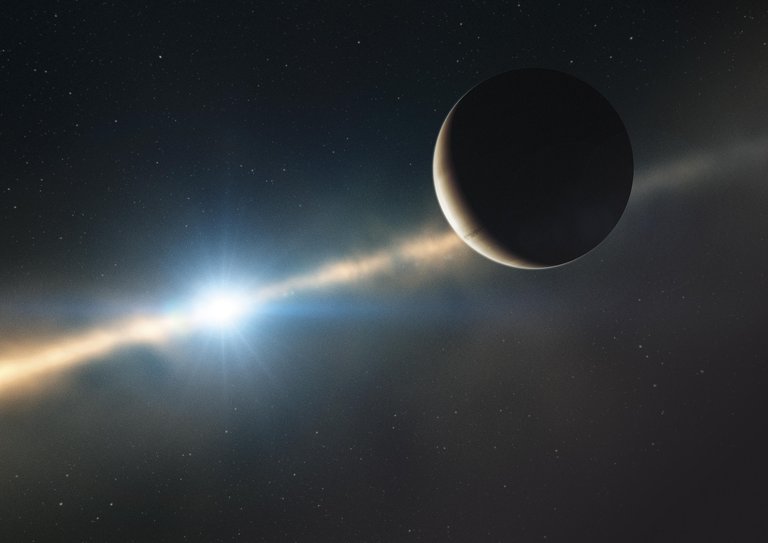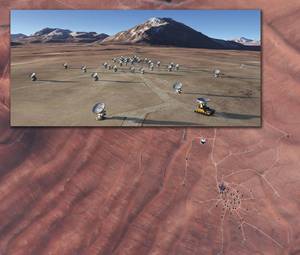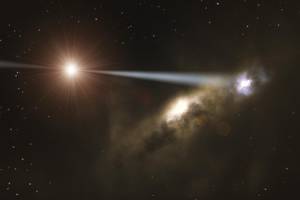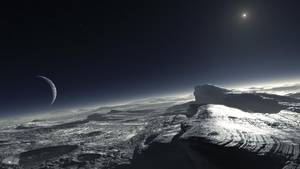An artist's gaze at faraway worlds

Luis Calçada is Portuguese, but lives in Munich, Germany. "I do English with work," he laughs, "my German is very bad." But he is a fast man, astronomer and artist who works combining both specialties.
He works in Munich because the ESO organization has the Education and Public Outreach section, the team responsible for education and outreach. ESO (European Southern Observatory) is an international public body for European astronomical research that has already built some of the world's largest telescopes and is in the process of building even larger telescopes. The department of Calçada is a small component of the operation of this great organization. "It is a very broad institution. We have engineers who design and manufacture telescopes. Then there are scientists who investigate the universe with those telescopes. And finally there's our team."
Calçada's work is to transmit to the public the work of scientists through images: "We bridge scientists and citizens. Therefore, our work begins with the results of the research. Scientists come to us and tell us what results they want to publish for the general public." Sometimes it is also the opposite way, that is, the communication team comes to scientists to ask them if they have something interesting to publish. And from there part of the work of the illustrator: "Scientists tell us the results of research and, if illustration is needed, we create them so the public can understand the results more easily. To explain the results, scientists usually use complex graphs, spectra represented by the spectrometer and material of this type. But we have to create a simpler interpretation for the general public."
To bridge the gap between scientists and the public, artists look both ways. Calçada sees the work he does necessary, since the results of scientists are surprising and interesting, but they are often difficult to understand. And although the results are not complex, they may be difficult to imagine. To cope with this work two professionals working together, astronomer and artist: "I also use what I know about astronomy. And often there is room for interpretation. In colors, for example, sometimes an image may be somewhat blue or somewhat redder. But there are always limits marked by science. Researchers will tell you that an object probably has more than red than blue, or that it has a lot of tendency to red because the temperature is the same or different, etc. Therefore, it is always something measured by scientists that helps you discover what the image is like. And then, of course, there is room for artistic freedom."
Balance between art and science

The key to good illustration is the mix of these two factors, which scientists measure and what the artist imagines. For this, in ESO there is always a small colloquium between the scientist and the artist to better understand what is probably real and what is a consequence of the imagination.
In this way they also illustrate what cannot be seen: "The variety of phenomena we represent is very wide. It can be the interior of a star, like that of our Sun, and it can be the beginning of the universe, that is, something very distant, both in time and space. And it is true that some of them do not see them, but scientists, over the years or centuries, have managed to understand these phenomena very well. Although we have never seen the inside of a star, we know (probably) how it is."
And as to explain this to an ordinary person, without scientific and physical knowledge, very simple terms are used, illustrators seek simple and explanatory illustrations. "Inside a star there is a core where hydrogen becomes helium through a nuclear reaction, etc. explains Calçada. "We already know that. Scientists can accurately calculate the kilometers to which the core layer begins, as they know the mass and measure the temperature of the star. All these small ingredients help to make an image of a star's interior."
Advantages of the digital age
From there the work begins. Turn on the computer and start creating illustration on the screen. Calçada's day to day is not like the work before a painter's white canvas: "I usually use 3D software to make the geometric part of the illustration. Then I use Photoshop to draw a little over. And when I have to do animations, I use the After Effects program to create the final part of the animation (a well-known post-production and special effects program). Therefore, I work preferably in digital format. There may be small exceptions, I have ever drawn, but in general they are digital techniques."

In this process that counts, the first steps would be almost impossible if you did not have the right software, and not only because it helps you draw with the perspective that geometry needs. "It is much more practical than the traditional digital format," says Calçadas-, "especially because software helps you. To illustrate Pluto's surface, for example, I used an atmospheric simulation software that gives me a physically correct result. It is necessary to define a series of atmospheric parameters (height, compactness, etc.) that generate a very natural looking image. In colors, for example, the software provides direct colors depending on the diffraction of light and other physical phenomena of the atmosphere."
In addition, these programs are not used exclusively by professional astronomers. Software available for anyone. Yes, the Calçada team combines many computer tools to get the best results. "In our work process we also use software that uses Hollywood or any other to make movies." Among them are landscape simulation software and similar ones, as these programs have tools for the simulation of atmospheres.
With this material there is also a paradox: "It is curious because these software are based on previous scientific research, whose results are already included in the digital tools that 3D software has for making movies or television ads. And now, we, scientists or scientists, simulate the world we are researching through this software."
This work is done for all space agencies. Sometimes the same artist works for more than one agency. This is how Calçada has acted, he has also done work for the ESA agency (and NASA has also used his illustrations). However, much of its activity takes place in the ESO communication group and lives the reality of this organization. He says that also from the corporate point of view of the organization it is necessary to make informative illustrations. And partly for economic reasons: "We are not a commercial organization, our goal is not to make money, but to discover the secrets of the universe and it is a fairly praiseworthy goal. But, of course, if we also want to make sophisticated telescopes, we need money and we must justify our work with the attention of the public." And with this the circle of money is closed, the illustrator is based on the results of the research, money is needed to obtain the results and people should be offered attractive results through the illustrations.
Image culture
When asked about the importance of representing invisible phenomena or objects, Calçada responds very pragmatically: "It is not a matter of philosophy, there is a practical reason: images are absolutely necessary. All. We watch movies with dramatic images, play video games with animations, colors and dramatic images. And the surprising results scientists get about how the universe works are not going to appear, for example, on the cover of a newspaper, if it is not accompanied by a spectacular image that you love."
In addition, Calçada recognizes that the objective is twofold: explain it and capture attention. It is a combination. "People need images to better understand things, even if there is no real image," says Calçada. "And we want people to understand what they see. Therefore, we work on two sides, on the one hand we need people to understand the concepts, people to see them and, on the other hand, to be interested in those concepts and to attend to people. We need these stories to appear in the newspapers."
The same happens in other media. Sometimes the work they do in the ESO communication department comes to Wikipedia and books, both for children and text.
In the end, images of invisible objects and phenomena reach all informative formats thanks to illustrations made by artists such as Calçada. That is why a lot of money is introduced into this activity. The big agencies have become aware of the importance of this work and will always seek a way to approach it, since in science there will always be spaces in which the illustrators of the invisible are necessary.
Buletina
Bidali zure helbide elektronikoa eta jaso asteroko buletina zure sarrera-ontzian













